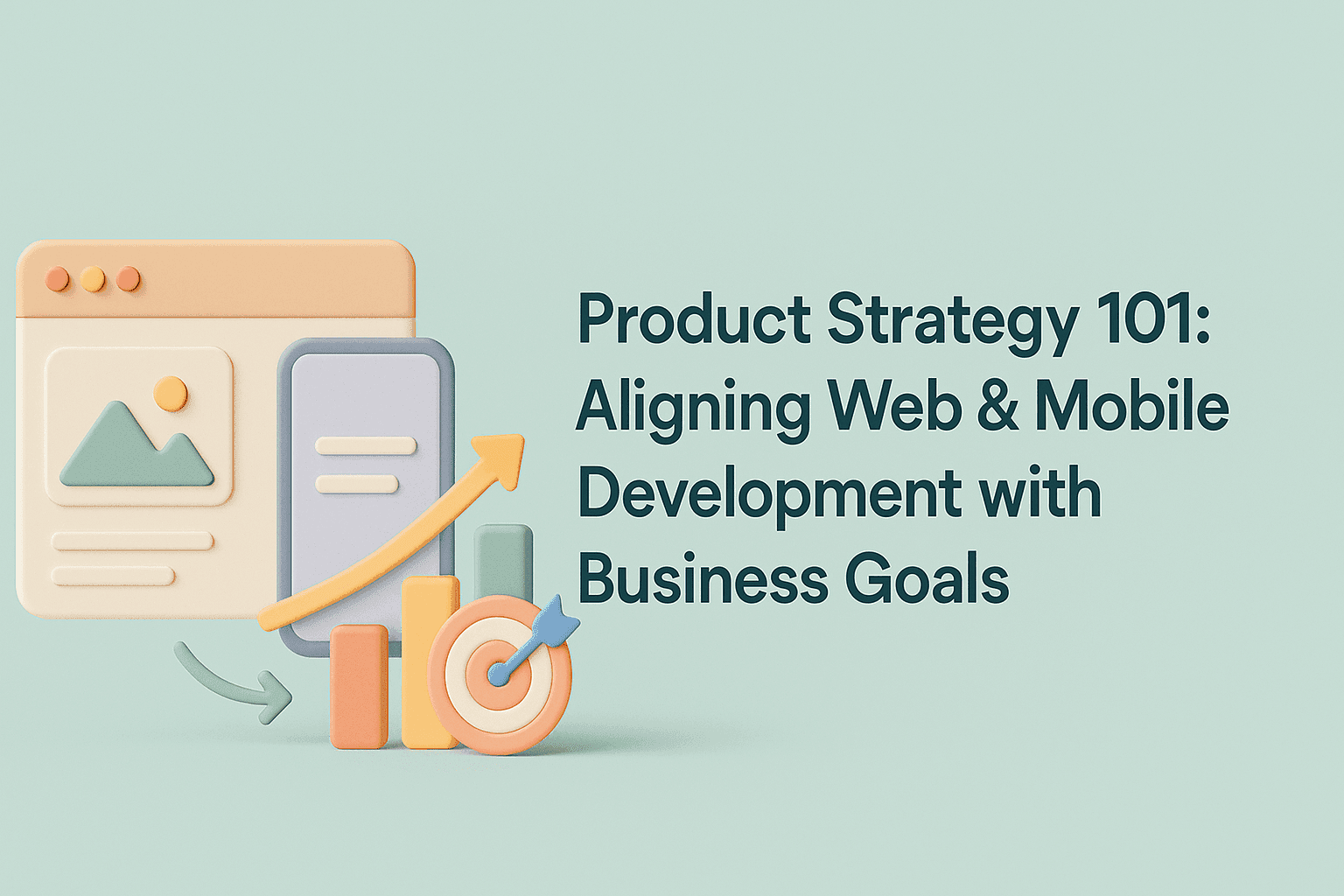Support center +91 97257 89197
Product developmentNovember 26, 2024
Product Strategy 101: Aligning Web & Mobile Development with Business Goals

In today's competitive digital landscape, merely building products isn't enough. Organizations must strategically align their web and mobile development efforts with clear business goals to ensure success. A well-defined product strategy acts as a guiding compass, helping companies navigate through technical complexities and market uncertainties to deliver impactful solutions.
But what exactly is a product strategy, and how can you effectively align it with your development projects? Let's explore.
Understanding Product Strategy
A product strategy is a high-level plan detailing what a business aims to achieve with its product, why it is essential, and how it aligns with the company's broader business objectives. It bridges the gap between the vision of the business and the day-to-day tasks involved in product development.
When it comes to web and mobile applications, product strategy becomes even more critical. It ensures that the technology developed directly supports business outcomes, driving profitability, efficiency, and customer satisfaction.
Why Align Development with Business Goals?
When technology efforts aren't strategically aligned, organizations risk developing products that fail to deliver meaningful value. The misalignment typically results in wasted resources, missed opportunities, and diminished market relevance.
Here’s why alignment matters:
- Maximized ROI: Clearly aligning product development with business goals ensures every feature built contributes directly to profitability and customer value.
- Focused Efforts: Teams spend less time on features that don't deliver strategic value and more on initiatives that have clear business impact.
- Enhanced Agility: An aligned strategy enables quick pivots and rapid responses to changing market conditions or customer needs.
- Improved Stakeholder Communication: Clearly articulated goals foster better collaboration among stakeholders, developers, and product managers.
Steps to Aligning Product Strategy with Web and Mobile Development
To effectively align your product strategy with your web and mobile development initiatives, consider following these critical steps:
Step 1: Clarify Your Business Goals
Before any coding begins, clearly define your business objectives. Whether it's increasing user engagement, generating higher revenues, or expanding market reach, having a clear goal ensures your tech initiatives are purposeful.
Step 2: Understand Your Users
User-centric development is foundational. Conduct thorough user research to deeply understand your audience’s needs, behaviors, and pain points. This ensures the final product genuinely solves real-world problems and delivers tangible value.
Step 3: Prioritize Features Strategically
Feature prioritization should be driven by alignment with business goals and user needs. Tools like the MoSCoW method (Must-have, Should-have, Could-have, Won't-have) can help you prioritize effectively.
Step 4: Implement Agile Methodologies
Agile frameworks like Scrum or Kanban facilitate iterative development, ensuring regular feedback loops and quick adjustments. This approach inherently promotes alignment, as adjustments can swiftly be made when business priorities evolve.
Step 5: Continuous Measurement and Adaptation
Use KPIs (Key Performance Indicators) such as user adoption rates, customer satisfaction scores, revenue targets, and engagement metrics. Continuously measure your product's performance and adjust strategies based on data-driven insights.
Common Pitfalls to Avoid
While aligning product strategy with development is essential, it's equally critical to avoid common pitfalls:
- Poor Communication: Lack of clarity between stakeholders and technical teams can lead to misunderstanding and misalignment.
- Inadequate User Research: Failing to understand your target audience can result in a product that doesn't meet market demands.
- Rigid Strategy: Strategies must remain flexible. An inability to adapt quickly can mean missed opportunities.
- Ignoring Feedback Loops: Failing to establish regular feedback mechanisms can lead to ongoing misalignment.
Avoiding these pitfalls requires vigilance, consistent communication, and flexibility throughout the product development lifecycle.
Real-World Examples
Consider how companies like Airbnb and Spotify have successfully aligned product strategy with their business objectives. Airbnb continuously adapts its mobile app and website based on deep insights into traveler preferences, directly contributing to higher user engagement and revenue growth.
Spotify leverages user analytics to deliver personalized experiences. Their product strategy directly focuses on user retention and engagement, resulting in sustained market leadership and customer loyalty.
Leveraging Technology for Strategic Alignment
Technology itself can support alignment:
- Project Management Tools: Platforms like Jira, Trello, or Asana improve transparency and collaboration, making alignment easier to achieve.
- Analytics Tools: Google Analytics, Mixpanel, or Amplitude provide insights that help align product improvements with user needs and business outcomes.
- Collaboration Platforms: Tools like Slack or Microsoft Teams facilitate communication, ensuring that all team members stay informed and aligned on strategic priorities.
Conclusion: Align for Success
A strategic approach to web and mobile development is essential for maximizing value, ensuring profitability, and sustaining growth. By following the outlined steps and staying vigilant about potential pitfalls, businesses can significantly enhance their product's impact, aligning technology initiatives closely with overarching business goals.
TLDR
Aligning your web and mobile development with business goals is essential for maximizing ROI, enhancing agility, and ensuring market relevance. Clarify business objectives, prioritize strategically, adopt Agile practices, and measure continuously for effective alignment. Avoid pitfalls like poor communication and rigid planning to maintain flexibility and responsiveness.
Now, go out there and strategically build the next digital innovation your business deserves!
FAQs
Product strategy ensures development aligns with business objectives, enhancing efficiency and maximizing ROI.
By setting clear goals, ensuring stakeholder alignment, and regularly measuring progress against strategic benchmarks.
Agile methodologies facilitate regular feedback and iteration, ensuring continuous alignment with evolving business priorities.
Success can be measured through metrics like customer satisfaction, revenue growth, user engagement, and ROI.
Common pitfalls include poor communication, unclear objectives, lack of stakeholder involvement, and insufficient user feedback.
Work with us







